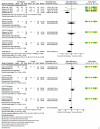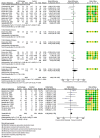Evaluation of Red Blood Cell Biochemical Markers and Coagulation Profiles Following Cell Salvage in Cardiac Surgery: A Systematic Review and Meta-Analysis
- PMID: 39458023
- PMCID: PMC11508477
- DOI: 10.3390/jcm13206073
Evaluation of Red Blood Cell Biochemical Markers and Coagulation Profiles Following Cell Salvage in Cardiac Surgery: A Systematic Review and Meta-Analysis
Abstract
Background: Individuals undergoing cardiac surgery face an increased risk of bleeding, as well as alterations in biochemical and coagulation patterns. Therefore, assessing the effectiveness of systems such as Cell Salvage is necessary to prevent potential surgical complications. Objective: To evaluate the efficacy of Cell Salvage in relation to the biochemical parameters of the red blood series and coagulation, as well as the risk of hemorrhage. Methods: A systematic review, accompanied by a meta-analysis, was executed via an extensive literature exploration encompassing Medline, CINAHL, Scopus, Web of Science, and the Cochrane Library. The inclusion criteria comprised studies in English or Spanish, without year restrictions, conducted in adults and with a randomized controlled trial design. Results: Twenty-six studies were included in the systematic review, involving a total of 2850 patients (experimental group = 1415; control group = 1435). Cell Salvage did not demonstrate superior outcomes compared to allogeneic transfusions in the management of post-surgical hemorrhage, as well as in total blood loss, platelet count, fresh frozen plasma, and fibrinogen. However, Cell Salvage showed a greater effectiveness for hemoglobin (moderate evidence), hematocrit (low evidence), post intervention D-dimer (low evidence), and some coagulation-related parameters (low evidence) compared to allogeneic transfusions. Finally, better results were found in the control group for INR parameters. Conclusions: The use of the Cell Salvage system holds high potential to improve the postoperative levels of biochemical and coagulation parameters. However, the results do not provide definitive evidence regarding its effectiveness for hemorrhage control, platelet count, fresh frozen plasma, and fibrinogen. Therefore, it is recommended to increase the number of studies to assess the impact of the Cell Salvage system on improvements in the red blood cell count and patient coagulation patterns. In addition, protocols should be homogenized, and variables such as the sex of the participants should be taken into account.
Keywords: biochemical markers; blood coagulation; blood transfusion; blood transfusion autologous; operative blood salvage; red blood cell; surgical blood loss.
Conflict of interest statement
The authors declare no conflicts of interest.
Figures







Similar articles
-
The effectiveness of cell salvage in extracorporeal circulation surgeries in relation to use of health resources after use: A systematic review and meta-analysis.Heliyon. 2024 Apr 27;10(9):e30459. doi: 10.1016/j.heliyon.2024.e30459. eCollection 2024 May 15. Heliyon. 2024. PMID: 38720744 Free PMC article.
-
Autologous platelet-rich plasma reduces transfusions during ascending aortic arch repair: a prospective, randomized, controlled trial.Ann Thorac Surg. 2015 Apr;99(4):1282-90. doi: 10.1016/j.athoracsur.2014.11.007. Epub 2015 Feb 7. Ann Thorac Surg. 2015. PMID: 25661906 Clinical Trial.
-
Erythropoietin plus iron versus control treatment including placebo or iron for preoperative anaemic adults undergoing non-cardiac surgery.Cochrane Database Syst Rev. 2020 Aug 13;8(8):CD012451. doi: 10.1002/14651858.CD012451.pub2. Cochrane Database Syst Rev. 2020. PMID: 32790892 Free PMC article.
-
Blood coagulation and autologous blood transfusion in cardiac surgery.J Clin Anesth. 1990 Nov-Dec;2(6):393-406. doi: 10.1016/0952-8180(90)90026-y. J Clin Anesth. 1990. PMID: 2271204 Review.
-
Ulinastatin reduces postoperative bleeding and red blood cell transfusion in patients undergoing cardiac surgery: A PRISMA-compliant systematic review and meta-analysis.Medicine (Baltimore). 2020 Feb;99(7):e19184. doi: 10.1097/MD.0000000000019184. Medicine (Baltimore). 2020. PMID: 32049853 Free PMC article.
References
-
- NICE NICE Recommends New Tests for Bleeding Problems during and after Cardiac Surgery. 2014. [(accessed on 26 July 2024)]. Available online: https://www.nice.org.uk/guidance/dg13/chapter/1-recommendations.
-
- Geissler R.G., Rotering H., Buddendick H., Franz D., Bunzemeier H., Roeder N., Kwiecien R., Sibrowski W., Scheld H.H., Martens S., et al. Utilisation of blood components in cardiac surgery: A single-centre retrospective analysis with regard to diagnosis-related procedures. Transfus. Med. Hemother. 2015;42:75–82. doi: 10.1159/000377691. - DOI - PMC - PubMed
Publication types
LinkOut - more resources
Full Text Sources

